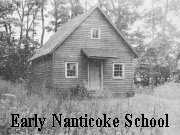In 1945, Juilan H. Steward, remarked in his book, "The Changing American Indian." "In a matter of years the last survivors will disappear without leaving any important cultural or racial mark on the national population." In the years since this statement was made however, a significant amount of research and writing demonstrates the error of Steward"s prediction. (This error is proven no more greater than in the vast number of Nanticoke decendents who have strove to keep their heritage and customs alive and to be passed on to newer generations.) Anthropologists comming to Sussex County in Delaware to study the Nanticoke tribe shortly after the turn of the century were amazed to see so many tribal customs still intact. The Nanticokes originally resided along the Nanticoke River on the Eastern Shore of Maryland but subsequently removed to Indian River Inlet in Delaware. By the time the first Europeans arrived in the Nanticoke homeland via Capt. John Smith's 1607 voyage to the New World, the tribe was firmly established. Smith counted ten villages with a population of more than 2000 on one short streach of the Chesapeake River alone.
The Nanticoke, for many years harassed by the Iroquois of central New York and suffering from encroachments by whites, ultimately took refuge among their former enemies the Iroquois. The political idealism of the Iroquois League, harsh though the methods may have been, showed forth in the policy of adopting subjugated peoples and giving them complete freedom besides inviting them to reside in their midst. There was however a nagative aspect to the process. Because of the dispersion of the Nanticoke, and through their association with other refugee tribes, they lost much of their traditional culture by merging their customs, blood, and later their language with other Indian groups.
After appoximately one hundred and fifty years of migration away from the continual encroachment of their land the Nanticoke in 1784 sought refuge and sanctuary at Indian River Inlet, Delaware. This particular group may be considered the survivors of the original tribal group, many having remained among the Six Nations of Iroquois while others moved to Oklahoma to join the Delaware Indians, and others to Canada. From the outset of the nineteenth century untill the present the Nanticoke have resided at Indian River Inlet and have successfully maintained their cultural identity, although the last person who spoke the Nanticoke language, Nau-Gwa-Ok-Wa, died sometime between 1840 and 1850.
Although the Nanticoke have long recoginized their mixed blood ancestry, White-Indian-Negro, they stauchly maintain their Indian identity. To insure their status as Indians, the Nanticokes in 1921 appeared before the legislature and demanded that they be called Indians and not "colored Persons." In the following session of the legislature there was passed, "An Act to Better Establish the identity of a Race of People known as the Offspring of the Nanticoke Indians." The Nanticoke, with the aid of Dr. Frank G. Speck, head of the Department of Anthopolgy of the University Of Pennsyivania, further strengthened their legal status with the formation of the Nanticoke Indian Association of Delaware.
One of the underlying objectives of the Association was to heighten interest in the old Indian traditions. An annual festival, commemorative of native campfire Powwows, was to be held each Thanksgiving. (The Nanticoke still hold annual Powwows in the Delaware area and Nanticoke decendents come to attend from all over the country.)
The preseeding, with the exception of two sentences in brackets, was taken from. "A Photographic Survey of Indian River Community dated 1977."
